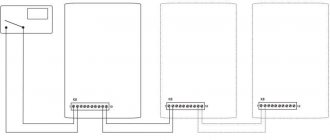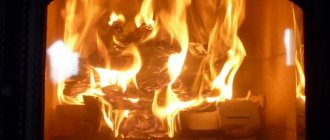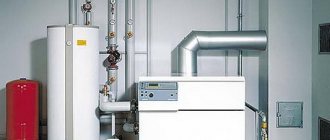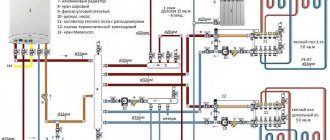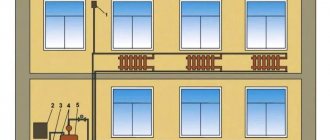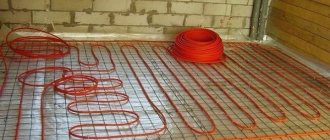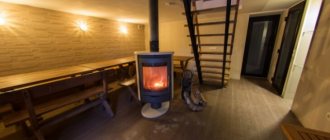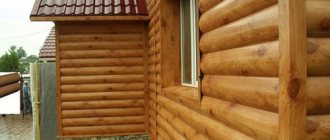These are usually gas boilers running on main gas, which are connected in a cascade in order to heat rooms from 500 sq.m. total area. It is quite rare that diesel or solid fuel boilers are combined together for main heating.
We are talking specifically about the main heat generators and heating of residential premises. Because cascade and modular boiler houses for heating large industrial premises can include “batteries” of coal or fuel oil boilers in quantities of up to one dozen.
So, as mentioned above, the main boilers are connected in a cascade, when a second identical boiler or slightly less powerful one complements the first heat generator.
Usually, during the off-season and mild frosts, the first boiler in the cascade operates. In cold weather or when it is necessary to quickly reheat the premises, a second boiler in the cascade is connected to it to help.
In a cascade, the main boilers are connected in series so that the second boiler reheats the water heated by the first heat generator. At the same time, of course, in this combination it is possible to isolate each boiler and a bypass, which allows water to bypass the isolated boiler.
In case of problems, any of the heat generators can be turned off and repaired, while the second boiler will regularly heat water in the heating system.
There is no special alternative to this system. As practice shows, it is better and more reliable to have 2 boilers with a capacity of 40 kW each than one boiler with a capacity of 80 kW. This allows you to repair each individual boiler without stopping the heating system.
It also allows each of the boilers to operate at its full power if necessary. While 1 high-power boiler would operate only at half power with low efficiency and increased clocking.
In what cases is it necessary to install two boilers?
The decision to install a second boiler most often arises in cases where the base boiler cannot independently carry the entire heat load of the in-house heating system. This scheme will eliminate the problem of power shortages in boiler equipment.
However, there are other reasons for connecting two boilers into one heating system to ensure sanitary temperature in the room:
- Incorrect preliminary calculation of the thermal power of heating installations.
- Increased heated area of the house.
- The need to increase the functionality of the heat supply source, for example, installing a hot water supply system or heating air in heating units.
- Increasing the period of autonomous operation of a heating source when using different types of energy carriers, for example, solid fuel during the day and electricity according to diftariff metering at night.
- The lack of reserves of the main fuel allows the use of two boiler units operating on different types of fuel.
Installation of a heating system with a heat accumulator
The use of such an element in a scheme with two boilers in one heating system has several features depending on the installed units:
- The heat accumulator, gas boiler and heating devices form a single closed system.
- Solid fuel boilers operating on wood, pellets or coal heat water, the thermal energy is transferred to a heat accumulator. This, in turn, heats the coolant circulating through a closed heating circuit.
To independently create a heating scheme with two boilers, you must purchase the following:
- Boiler.
- Thermal accumulator.
- Expansion tank of appropriate volume.
- Hose for additional coolant removal.
- There are 13 shut-off valves.
- Pump for forced circulation of coolant in the amount of 2 pieces.
- Three-way valve.
- Water filter.
- Steel or polypropylene pipes.
Such a scheme is characterized by operation in several modes:
- Transfer of thermal energy from a solid fuel boiler through a heat accumulator.
- Heating water with a solid fuel boiler without using this device.
- Receiving heat from a gas boiler connected to a gas cylinder.
- Connecting two boilers at the same time.
Requirements for a room with two boilers
In the case when the same type of heating sources are selected, the requirements for the furnace are applied to the specific type of fuel used: gas, coal, pallets or electric heating.
The boiler room in the house needs to be treated with due attention
If units operating on different types of energy carriers are selected, the premises must comply with both, and the larger indicator is selected.
Requirements for units using solid fuel:
- The floor area of the combustion room is selected according to the total thermal power of the devices: up to 32 kW, 7.50 m2 is required, up to 62 kW - 13.50 m2, up to 200 kW - 15.0 m2.
- A unit of more than 30 kW is installed in the center of the combustion chamber to ensure reliable circulation of air masses.
- The surface elements of the combustion chamber: floor, walls, ceiling and partitions are made of fire-resistant building materials, using waterproofing protection.
- The boiler is installed on a reliable foundation made of fire-resistant building materials.
- For units up to 30 kW, the requirements for fire resistance of the floor are lower; it is enough to cover it with a steel sheet.
- The supply of solid fuel is stored in a separate dry room, and the daily supply can be located in the boiler room at a distance of at least 1 m from the boiler.
- The furnace room must have a door and windows installed that can provide reliable air circulation three times based on the existing volume of the room.
Requirements for furnace units with gas-fired boilers:
- Gas boilers with a total power of up to 30 kW can be installed in non-residential premises of a house where there are windows and doors that can provide 3 times air circulation.
- When the power of the gas source is more than 30 kW, a separate furnace room is required with a ceiling height of at least 2.5 m and a total area of more than 7.5 m2.
- If this equipment will be installed in a kitchen in which a gas stove operates, then the room must be at least 15 m2.
Radiator installation
The main elements of the heating system in the premises of the house are radiators. Currently, many experts have begun to advise not to purchase traditional cast iron batteries, since they are heavy and have significantly worse properties than products made from a bimetallic alloy. In addition, the latest products look much more aesthetically pleasing and have good heat dissipation.
There are several types of radiator wiring
The most common is the lateral one-way connection. In this case, the inlet pipe is connected to the upper branch pipe, and the outlet pipe to the lower one. Thanks to this, maximum heat transfer is achieved, and when connected in reverse, the power is reduced by approximately 10%.
The main advantage of the bottom connection is aesthetics - in this case, both pipes are hidden behind the baseboard. The pipes are located at the bottom of the pipe and face the floor. Diagonal connection is mainly used for multi-section radiators. As a result, hot water is supplied from one side into the upper pipe, and on the other, it is discharged through the lower one.
Radiators are connected in two ways: in series and in parallel. With a parallel connection, water moves under pressure inside the entire system, and if one battery breaks down, all heating is turned off until the repair is completed. With a parallel connection, radiators can be changed without turning off the heating system.
The number of sections of the device must be calculated depending on the specific situation. This largely depends on the climate of the region and the quality of insulation of the house. But according to the standard, 1 radiator section is capable of heating 2 “squares” of area if the ceiling height is no more than 2.7 m
This formula can be considered conditional, since it is important to take into account other parameters: the thickness of the walls and their material, the type and parameters of insulation (for more details: “How to choose insulation for heating pipes and whether it is needed”), heater power, climatic features of the region. Double-circuit heating boilers should be selected taking into account the area of the room, but the heating efficiency largely depends on the area of the house and the type of radiators
Connection diagrams
Connecting two different types of boilers in one thermal circuit is a very important step. Any even minor mistake, except for the ineffective operation of heating equipment, can create an emergency situation in the house.
The calculation of a two-boiler connection diagram should be entrusted to the design organization so that they can select the most optimal pair of units with parallel or series piping and control options: automatic or manual.
Automatic boilers
From a hydraulic point of view, this scheme does not differ much from the manual control principle, only 2 check valves are installed in it.
This is required in order to eliminate “parasitic” or idle coolant flows through the boiler unit, which is in reserve. This problem is also solved by installing a hydraulic arrow. Check valves are installed on the return line, directed towards each other.
This system will also require a thermostat that turns off the pump for forced circulation. When the coal burns out in the boiler, there will be no point in circulating idle water through the stopped device, thereby creating resistance to the operation of the second device.
Connection diagram for 2 manually controlled boilers
In this option, to ensure consistency in the operation of the boiler units, only shut-off and control valves are needed. All operational switching between units is performed by the operator’s hands by opening/closing 2 valves on the return coolant line. To completely stop the flow of hot water, you will need to turn off the 4th valves, respectively, in pairs on the supply and return.
In such schemes, I provide expansion tanks to compensate for the thermal expansion of water when heating the boiler from a cold state. In order to save money, it is not recommended to leave one tank, since it may not cope with the load when two boilers are operating.
Series and parallel connection
These are two generally accepted schemes for piping two boilers operating in pairs.
Sequential, involves sequential switching on of units without additional lines and nodes. In this case, the first unit in the direction of water movement heats it, and the second unit heats it to the required temperature.
The parallel scheme involves the arrangement of two points of connection of flows on forward and reverse coolants. In this option, the boilers operate independently of each other.
Sequential circuit
The first option is used for small heating sources. In practice, it is quite rare and is considered impractical, since it is impossible to remove one unit for repair operations without affecting the functionality of the other.
Such a scheme will be inoperative if even one unit malfunctions. Today, this scheme has been partially modernized through the installation of bypass lines and additional shut-off and control valves.
Parallel connection of different types of boiler units in a single system is considered advantageous and allows the installation of a hydraulic switch and an automatic control unit.
Parallel connection
Installation of gas equipment
When a double-circuit heating system is installed, the diagram must be followed exactly - only in this case will the equipment work correctly and efficiently.
The body of the heating unit should not be adjacent to the wall, nor should it be installed in niches.
- electrical;
- hydraulic;
- gas
The outer pipes are necessary to connect the equipment to the heating system. On the left, hot water flows into the batteries, and on the right, cooled water returns for heating. Thus, connecting a double-circuit heating boiler is quite simple; you just need to follow the recommendations of specialists.
A coarse filter must be installed on the return pipe connection - this is necessary in order to protect the boiler from debris and rust that will accumulate in the pipes. If it is not installed, the service life of the equipment will be significantly reduced. Screw the filter to the pipe in the direction of the arrow to the boiler.
The water supply and return pipes are equipped with taps, with the help of which, in the event of a heating unit breakdown, the water can be turned off. If this is not done, then before starting the repair you will have to drain the coolant from the heating system, and this will take time. The water supply circuit is connected in approximately the same way; a filter is installed on the cold water supply to prevent the device from becoming clogged with debris. To cut off the pipeline circuit, it is also necessary to install taps.
When installing a double-circuit heating boiler, several conditions must be observed. Before starting the system, you need to make sure that the cold and hot water taps have not been mixed up. A mistake in this can lead to dire consequences - even an explosion of the gas boiler, so you should not take connecting the equipment lightly.
Next, the expansion tank is installed. It is needed to compensate for the expansion of the heating system due to increased pressure. The volume of the tank should be approximately equal to 10% of the amount of coolant in the entire system. Most often, the tank is installed between the boiler and the circulation pump, but it can also be placed in another place where it will not interfere. It will also come in handy if the pressure in a double-circuit boiler drops.
Piping diagrams by type of boiler
It is quite simple to link the operation of two units of the same type, but real operating conditions do not always allow this. More often it is necessary to combine the operation of units not only with different power, but also with different energy carriers.
The most popular pairs of two-boiler schemes:
- gas fuel and electricity;
- gas and solid fuel;
- firewood and electricity;
- propane and electric power;
- heating oil and electricity;
- pellets and electricity.
Connecting a gas and floor-standing solid fuel boiler
This is the most technically complex method of piping two boilers, since it requires the implementation of a smoke ventilation system and compliance with the dimensions of the room for the installation of large fire-hazardous objects.
It is best to entrust the development of the diagram to a design organization, since it must take into account all the rules of safe operation for both gas and solid fuel boilers.
The optimal mode in the heating network is achieved when installing a multi-circuit system; in this case, it is necessary to connect boilers with two independent circuits.
Considering that solid fuel devices are practically impossible to regulate the temperature of the coolant, an open heat supply system with the installation of an expansion tank should be used.
Moreover, a closed heat supply system using gas and solid fuel boilers is unacceptable and is a serious violation of fire safety rules.
Electric and gas
A very effective and easy to manage scheme. By combining gas and electric boilers in one heating system, it is possible to achieve a much greater thermal effect, and with the correct combination of operating modes of the units, the scheme is more economical than traditional gas boilers.
The leading function in this pair is usually performed by a gas boiler unit, which has the lowest cost of thermal energy. The electric boiler is switched on at night using the cheapest tariff for electricity metering.
When choosing the thermal power of equipment, it is necessary to focus on this boiler piping scheme. The gas unit must be more powerful, and the electric boiler must have peak power to operate at night or at peak heat demand. There are no prohibitions on the joint operation of this pair of boilers in regulatory materials. However, their installation will require approval of the boiler house design from both the gas service and energy supervision.
Connecting a solid fuel and electric boiler
Connecting a solid fuel and electric boiler is also an effective implementation of a combined heat supply source. The basic boiler is solid fuel, which is capable of operating at one load for at least 8 hours. It warms up the heat supply facility well.
After the fuel burns out and the coolant cools down to 60 C, the electric boiler is switched on in the mode of maintaining the temperature schedule. For greater energy efficiency, it is advisable to have a hot water storage tank, which is heated by an electric boiler during the night economy mode.
The solid fuel boiler itself is difficult to regulate due to the inertia of the combustion process; it will produce almost nominal performance until the fuel burns out.
In this case, working to heat the primary circuit in the storage tank, adjustment of the heating mode will be carried out in the secondary heating circuit from the storage tank through a three-way valve by mixing cold water from the return coolant with hot water from the supply line.
The feasibility of using automatic and manual switching between two boilers
Let's consider the following five options with various units in conjunction with an electric boiler, which is in reserve and must turn on at the right time:
- Gas + Electric
- Firewood + Electric
- Liquefied gas + Electro
- Solar + Electro
- Pellet (granular) + Electro
Pellet and electric boiler
The combination of connecting two boilers - a pellet and an electric boiler - is best suited for automatic switching on and manual switching is also allowed.
A pellet boiler may stop because it has run out of fuel pellets. It got dirty and wasn't cleaned. The electric one must be ready to turn on to replace the stopped boiler. This is only possible with automatic connection. Manual connection in this option is only suitable when you permanently live in a house where such a heating system is installed.
Diesel boilers fuel and electricity
If you live in a house with such a system for connecting two heating boilers, a manual connection is quite suitable for you. The electric boiler will operate as an emergency boiler in case the boilers fail for some reason. They didn’t just stop, they broke down and require repairs. Automatic switching is also possible as a function of time. An electric boiler can operate in tandem with liquefied gas and a solar boiler at a night rate. Due to the fact that the night tariff is cheaper per 1 kW/hour than 1 liter of diesel fuel.
Combination of electric boiler and wood boiler
This combination of connecting two boilers is more suitable for automatic connection and less suitable for manual connection. A wood boiler is used as the main one. It heats the room during the day, and turns on the electricity to add heat at night. Or if you are not living in the house for a long time, an electric boiler maintains the temperature so as not to freeze the house. Manual operation is also possible to save electricity. The electric boiler will turn on manually when you leave and turn off when you return and start heating the house using a wood-fired boiler.
Combination of gas and electric boilers
In this combination of connecting two boilers, the electric boiler can act as both a backup and a main one. In this situation, a manual connection scheme is more suitable compared to an automatic one. The gas boiler is a proven and reliable unit that can operate for a long time without breakdowns. At the same time, connecting an electric boiler to the system for backup in automatic mode is impractical. If the gas boiler fails, you can always manually turn on the second unit.
Multi-fuel boilers instead of two boilers
For small heat supply facilities, it is possible to install boilers whose design allows for the simultaneous combustion of several types of fuel.
The best pairs have proven themselves:
- solid fuel - electricity;
- main gas - liquefied gas;
- main gas - fuel oil;
- liquid fuel - electricity;
- liquefied gas - electricity;
The first pair is the most common and is implemented in many domestic solid fuel boilers, when heating elements with a load of at least 50% of the rated power are installed in the heating circuit.
Thus, having decided to equip a boiler room with two boilers capable of working together, the user definitely wins by receiving a more modern energy-efficient combined heat supply scheme.
With the correct selection of equipment, you can achieve not only the minimum cost of thermal energy, but also increase the level of automation, reliability and safety of the heating source.
